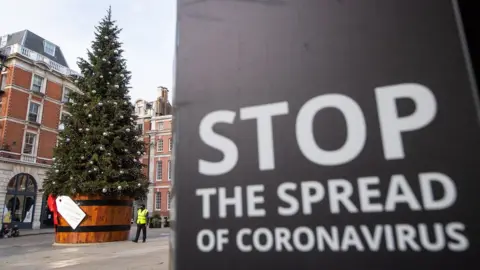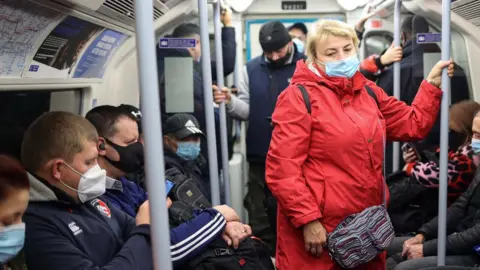Should London be split into different Covid restriction tiers?
 PA Media
PA MediaLondon is a city of contrasts containing leafy suburbs, urban high rises and sprawling high-streets. So should the capital be split into more localised regions with different lockdown restrictions?
Several MPs have called on the government not to consider the capital as one area when it comes to coronavirus.
Instead, it should be split up by inner city and outskirts or borough-by-borough to better reflect local infection rates.
They argue areas with low-infection rates shouldn't be "punished unnecessarily" by going into a higher tier designed for suppressing large outbreaks of coronavirus.
Regions will find out which tier they are in on Thursday but the prime minster has argued against splitting up the capital.
As a whole London has an infection rate of 180.5 cases per 100,000, well below average the England national average of 217.6 cases per 100,000.
But between London's boroughs there is huge variation.
 PA Media
PA MediaHavering, London's worst affected borough, had a weekly case rate of 360 cases per 100,000 up to 20 November.
This is more than three times higher than Camden's 97 cases per 100,000 and Richmond's 108.6.
"London is a wonderful, diverse city - it's not just one unit," Conservative MP for Wimbledon, Stephen Hammond said.
"We ought to look at London on a borough-by-borough or sub-regional basis," Mr Hammond said.
"I don't see why Londoners should suffer when the rest of the country is being looked at on a more localised basis."
A borough-by-borough basis is also supported by Bob Blackman, Conservative MP for Harrow East.
"What we need to avoid is a situation where the borough's with the lowest infection rates are placed under the same restrictions as those with the highest infection rates and therefore punished unnecessarily," Mr Blackman said.
"In the outskirts of London there are only a few boroughs which have high infection rates."
 Reuters
ReutersBut not everyone agrees.
Despite representing one of London's least infected boroughs Sarah Olney doesn't want her Richmond constituency to potentially end up in a lower tier.
The Liberal Democrat MP said: "I want Richmond to remain as part of an overall London tier, to discourage people from travelling here and increasing the risk of infections spreading."
The government has not released the exact formula it will use to decide what restrictions will be applied to which region.
In London the rate of infection appears to be slowing but the latest figures show the number of weekly deaths is starting to creep up.
Deaths linked to coronavirus in London have dropped drastically from a peak in early April.
In the latest week with complete data, the week ending 13 November, the number of people who died after contracting coronavirus in the capital jumped by 42% from 87 to 124.
 Reuters
ReutersPrime Minister Boris Johnson has said the three-tiered regional measures will return from 2 December, but added each tier would be toughened.
Mr Johnson argued against splitting London into smaller regions with different tiers.
In the House of Commons he said despite London's diversity "it is held together by a very dense mass transit system" making it "difficult to separate one bit of London from another".
In this he's supported by the Mayor of London, Sadiq Khan, who has said smaller regions will make enforcing the rules harder.
The mayor's office argues that setting different rules for high streets, pubs and restaurants in neighbouring boroughs could push footfall between areas "with unintended consequences".
A spokesman for the mayor said the Met Police "had a centrally coordinated approach" to enforcing lockdown restrictions.
"Any difference between boroughs would not help clarity of message or rules," he said.
